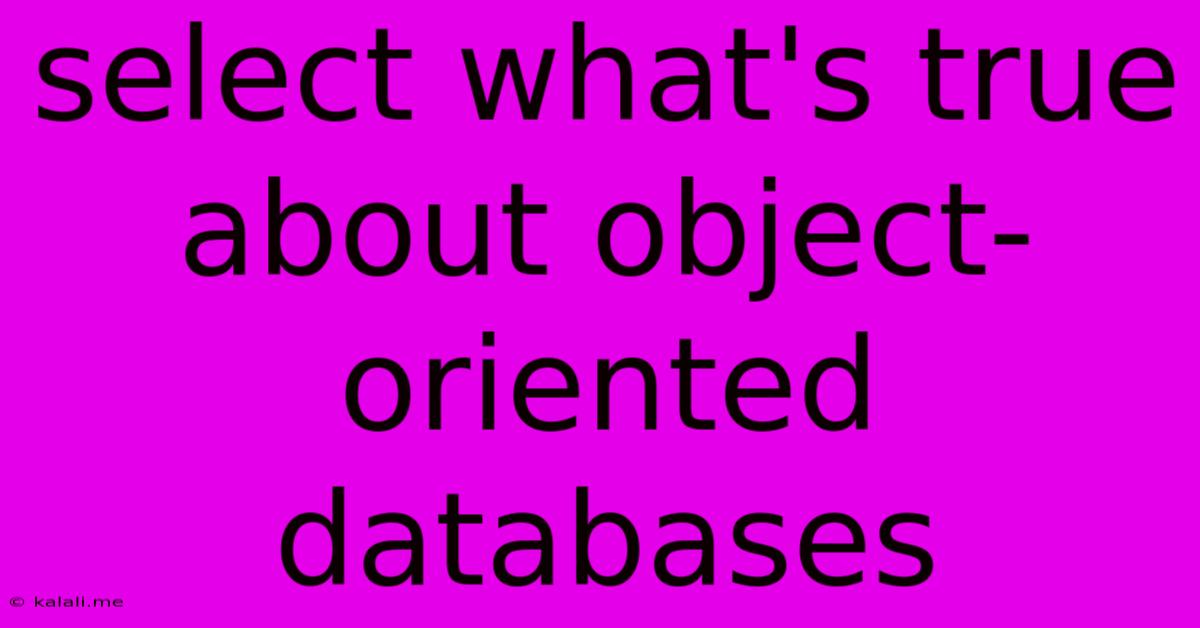Select What's True About Object-oriented Databases
Kalali
Jun 15, 2025 · 3 min read

Table of Contents
Selecting What's True About Object-Oriented Databases
Object-oriented databases (OODBs) represent a powerful alternative to traditional relational databases, particularly in applications requiring complex data modeling and management. Understanding their strengths and weaknesses is crucial for choosing the right database technology for your project. This article explores several statements about OODBs, identifying which are accurate and clarifying any misconceptions. We will delve into the core characteristics of OODBs, comparing and contrasting them with relational database management systems (RDBMS).
What Makes an Object-Oriented Database Unique?
Before we examine the truth statements, let's establish a foundational understanding of OODBs. Unlike relational databases that store data in tables with rows and columns, OODBs store data as objects. These objects encapsulate both data (attributes) and methods (functions) that operate on that data. This object-oriented paradigm offers several key advantages:
- Complex Data Handling: OODBs excel at managing complex data structures, such as graphs, networks, and multimedia objects, which can be challenging to represent efficiently in relational databases.
- Data Integrity: The encapsulation of data and methods promotes data integrity by controlling access and modification through defined interfaces.
- Inheritance and Polymorphism: These object-oriented principles allow for efficient code reuse and flexible data modeling. Inheritance enables the creation of new objects based on existing ones, while polymorphism allows objects of different classes to respond to the same method call in different ways.
- Improved Performance for Specific Applications: In applications involving complex object relationships, OODBs can offer performance advantages over RDBMS, particularly in query processing.
Evaluating Statements About Object-Oriented Databases
Now, let's assess some common statements about OODBs:
1. "Object-oriented databases are always superior to relational databases." FALSE.
While OODBs offer advantages for specific applications, they are not universally superior. RDBMS remain dominant due to their maturity, widespread adoption, and robust tooling. The best choice depends on the application's requirements. For simple data models and high-volume transactional processing, a relational database might be more suitable.
2. "OODBs are inherently more scalable than RDBMS." FALSE.
Scalability depends on various factors, including database design, hardware infrastructure, and the specific database implementation. While some OODBs can achieve significant scalability, it's not an inherent characteristic. Many modern RDBMS also offer excellent scalability solutions.
3. "Object-oriented databases directly support complex data types like images and videos." TRUE.
This is a significant advantage of OODBs. They can directly store and manage these complex data types as attributes of objects, whereas RDBMS often require specialized handling mechanisms.
4. "OODBs are easier to learn and use than relational databases." FALSE.
The object-oriented paradigm, while powerful, can have a steeper learning curve than the relational model, especially for developers accustomed to SQL. The query languages used in OODBs are often more complex than SQL.
5. "Object-oriented databases are widely used in mainstream enterprise applications." FALSE.
While OODBs have niche applications, they are not as prevalent as RDBMS in mainstream enterprise systems. The dominance of RDBMS in established enterprise environments makes migration to OODBs a significant undertaking.
6. "OODBs are better suited for applications requiring complex object relationships." TRUE.
The inherent ability to model complex relationships directly using objects makes OODBs a strong choice for applications dealing with intricate data structures and interconnections, such as CAD systems, GIS applications, and knowledge representation systems.
Conclusion
Selecting the appropriate database technology is a critical design decision. While object-oriented databases offer substantial advantages for certain applications, they are not a universal replacement for relational databases. A thorough understanding of your project's specific requirements—including data complexity, scalability needs, and developer expertise—is crucial for making an informed decision. Carefully weighing the strengths and limitations of each approach will ensure you choose the best solution for your needs.
Latest Posts
Latest Posts
-
Triangles Abc And Def Are Similar
Jun 15, 2025
-
The Breaking Down Of Rocks Is Called
Jun 15, 2025
-
Which Vitamin Is Mismatched With Its Deficiency
Jun 15, 2025
-
Greater Than Less Than Decimals Calculator
Jun 15, 2025
-
What Are The Conjugate Base And Conjugate Acid Of H2po4
Jun 15, 2025
Related Post
Thank you for visiting our website which covers about Select What's True About Object-oriented Databases . We hope the information provided has been useful to you. Feel free to contact us if you have any questions or need further assistance. See you next time and don't miss to bookmark.